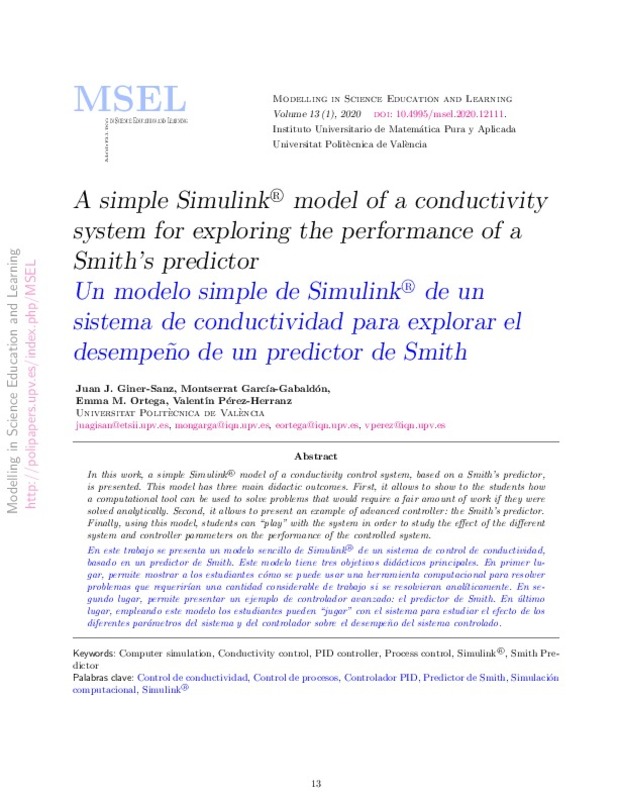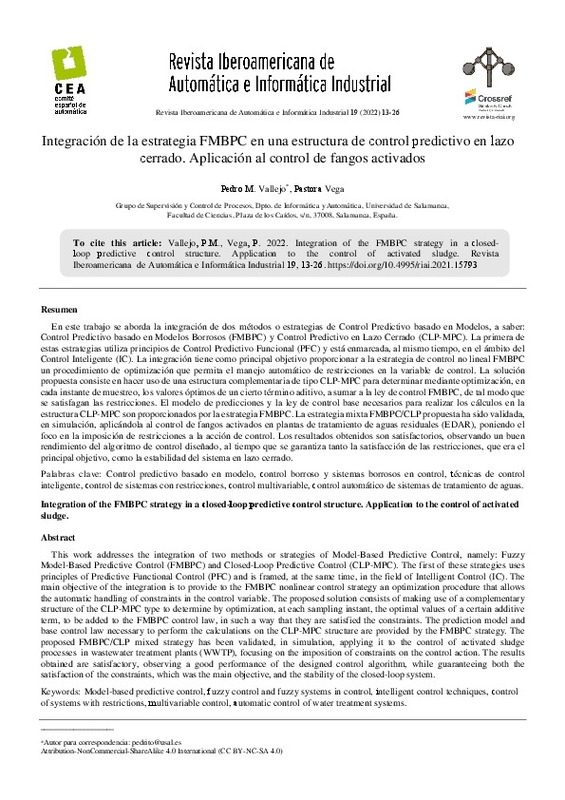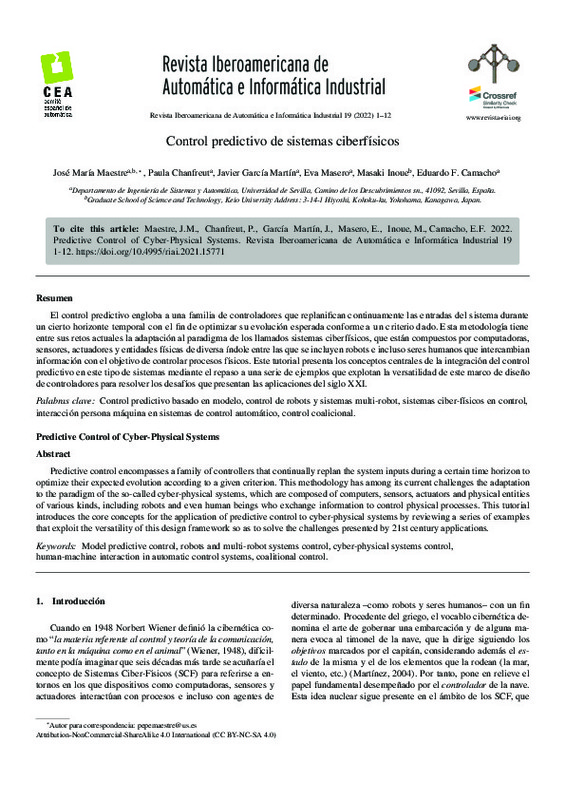JavaScript is disabled for your browser. Some features of this site may not work without it.
Buscar en RiuNet
Listar
Mi cuenta
Estadísticas
Ayuda RiuNet
Admin. UPV
A simple Simulink® model of a conductivity system for exploring the performance of a Smith’s predictor
Mostrar el registro sencillo del ítem
Ficheros en el ítem
| dc.contributor.author | Giner-Sanz, Juan José
|
es_ES |
| dc.contributor.author | García Gabaldón, Montserrat
|
es_ES |
| dc.contributor.author | Ortega Navarro, Emma María
|
es_ES |
| dc.contributor.author | Pérez Herranz, Valentín
|
es_ES |
| dc.date.accessioned | 2020-03-06T12:04:58Z | |
| dc.date.available | 2020-03-06T12:04:58Z | |
| dc.date.issued | 2020-01-28 | |
| dc.identifier.uri | http://hdl.handle.net/10251/138455 | |
| dc.description.abstract | [EN] In this work, a simple Simulink® model of a conductivity control system, based on a Smith’s predictor, is presented. This model has three main didactic outcomes. First, it allows to show to the students how a computational tool can be used to solve problems that would require a fair amount of work if they were solved analytically. Second, it allows to present an example of advanced controller: the Smith’s predictor. Finally, using this model, students can “play” with the system in order to study the effect of the different system and controller parameters on the performance of the controlled system. | es_ES |
| dc.description.abstract | [ES] En este trabajo se presenta un modelo sencillo de Simulink de un sistema de control de conductividad, basado en un predictor de Smith. Este modelo tiene tres objetivos didácticos principales. En primer lugar, permite mostrar a los estudiantes cómo se puede usar una herramienta computacional para resolver problemas que requerirán una cantidad considerable de trabajo si se resolvieran analíticamente. En segundo lugar, permite presentar un ejemplo de controlador avanzado: el predictor de Smith. En último lugar, empleando este modelo los estudiantes pueden "jugar" con el sistema para estudiar el efecto de los diferentes parámetros del sistema y del controlador sobre el desempeño del sistema controlado. | es_ES |
| dc.description.sponsorship | The authors are very grateful to the Generalitat Valenciana and to the European Social Fund, for their economic support in the form of Vali+d postdoctoral grant (APOSTD-2018- 001) | es_ES |
| dc.language | Inglés | es_ES |
| dc.publisher | Universitat Politècnica de València | es_ES |
| dc.relation.ispartof | Modelling in Science Education and Learning | es_ES |
| dc.rights | Reconocimiento - No comercial (by-nc) | es_ES |
| dc.subject | Computer simulation | es_ES |
| dc.subject | Conductivity control | es_ES |
| dc.subject | PID controller | es_ES |
| dc.subject | Process control | es_ES |
| dc.subject | Simulink® | es_ES |
| dc.subject | Smith Predictor | es_ES |
| dc.subject | Control de conductividad | es_ES |
| dc.subject | Control de procesos | es_ES |
| dc.subject | Controlador PID | es_ES |
| dc.subject | Predictor de Smith | es_ES |
| dc.subject | Simulación computacional | es_ES |
| dc.subject | Simulink | es_ES |
| dc.title | A simple Simulink® model of a conductivity system for exploring the performance of a Smith’s predictor | es_ES |
| dc.title.alternative | Un modelo simple de Simulink de un sistema de conductividad para explorar el desempeño de un predictor de Smith | es_ES |
| dc.type | Artículo | es_ES |
| dc.identifier.doi | 10.4995/msel.2020.12111 | |
| dc.relation.projectID | info:eu-repo/grantAgreement/GVA//APOSTD%2F2018%2F001/ | es_ES |
| dc.rights.accessRights | Abierto | es_ES |
| dc.contributor.affiliation | Universitat Politècnica de València. Escuela Técnica Superior de Ingenieros Industriales - Escola Tècnica Superior d'Enginyers Industrials | es_ES |
| dc.contributor.affiliation | Universitat Politècnica de València. Instituto de Seguridad Industrial, Radiofísica y Medioambiental - Institut de Seguretat Industrial, Radiofísica i Mediambiental | es_ES |
| dc.contributor.affiliation | Universitat Politècnica de València. Departamento de Ingeniería Química y Nuclear - Departament d'Enginyeria Química i Nuclear | es_ES |
| dc.description.bibliographicCitation | Giner-Sanz, JJ.; García Gabaldón, M.; Ortega Navarro, EM.; Pérez Herranz, V. (2020). A simple Simulink® model of a conductivity system for exploring the performance of a Smith’s predictor. Modelling in Science Education and Learning. 13(1):13-20. https://doi.org/10.4995/msel.2020.12111 | es_ES |
| dc.description.accrualMethod | OJS | es_ES |
| dc.relation.publisherversion | https://doi.org/10.4995/msel.2020.12111 | es_ES |
| dc.description.upvformatpinicio | 13 | es_ES |
| dc.description.upvformatpfin | 20 | es_ES |
| dc.type.version | info:eu-repo/semantics/publishedVersion | es_ES |
| dc.description.volume | 13 | es_ES |
| dc.description.issue | 1 | es_ES |
| dc.identifier.eissn | 1988-3145 | |
| dc.relation.pasarela | OJS\12111 | es_ES |
| dc.contributor.funder | Generalitat Valenciana | es_ES |
| dc.contributor.funder | European Social Fund | es_ES |
| dc.description.references | Ambrose, S.A., Bridges, M.W., DiPietro, M., Lovett, M.C., Norman, M.K. (2010). What factors moti-vate students to learn. How learning works: Seven research based principles for smart teaching, 66-90. New York, USA: John Wiley & Sons. | es_ES |
| dc.description.references | Astrom, K., Ostberg, A.B. (1986). A teaching laboratory for process control. IEEE Control Systems Magazine 6, 37-42. https://doi.org/10.1109/MCS.1986.1105142 | es_ES |
| dc.description.references | Edgar, T.F., Ogunnaike, B.A., Downs, J.J., Muske, K.R., Bequette, B.W. (2006). Renovating the undergraduate process control course. Computers & chemical engineering 30, 1749-1762. https://doi.org/10.1016/j.compchemeng.2006.05.012 | es_ES |
| dc.description.references | Giner-Sanz, J.J., García-Gabaldón, M., Ortega, E.M., Pérez-Herranz, V. (2014). A simple Simulink® model of a conductivity system for exploring PID controller performance. IV Congreso de Innovación Docente en Ingeniería Química (CIDIQ). Santander, Spain. | es_ES |
| dc.description.references | Hernández-Armenteros, J., Pérez-García, J.A. (2018). La Universidad Española en Cifras 2016-2017. Valencia, Spain: Crue Universidades Españolas. | es_ES |
| dc.description.references | Johansson, K.H., Horch, A., Wijk, O., Hansson, A. (1999). Teaching multivariable control using the quadruple-tank process. 38th IEEE Conference on Decision and Control. Phoenix, USA. https://doi.org/10.1109/CDC.1999.832889 | es_ES |
| dc.description.references | Salmerón-Manzano, E., Manzano-Agugliaro, F. (2018). The Higher Education Sustainability through Virtual Laboratories: The Spanish University as Case of Study. Sustainability 10, 4040. https://doi.org/10.3390/su10114040 | es_ES |











